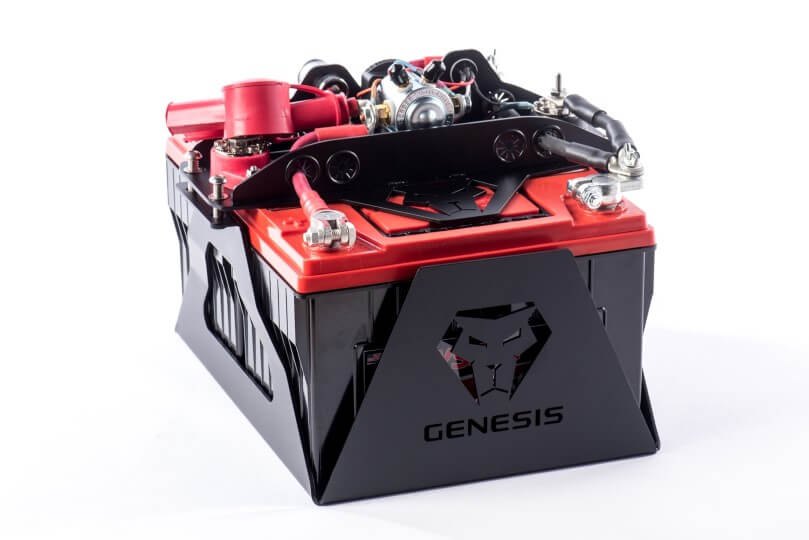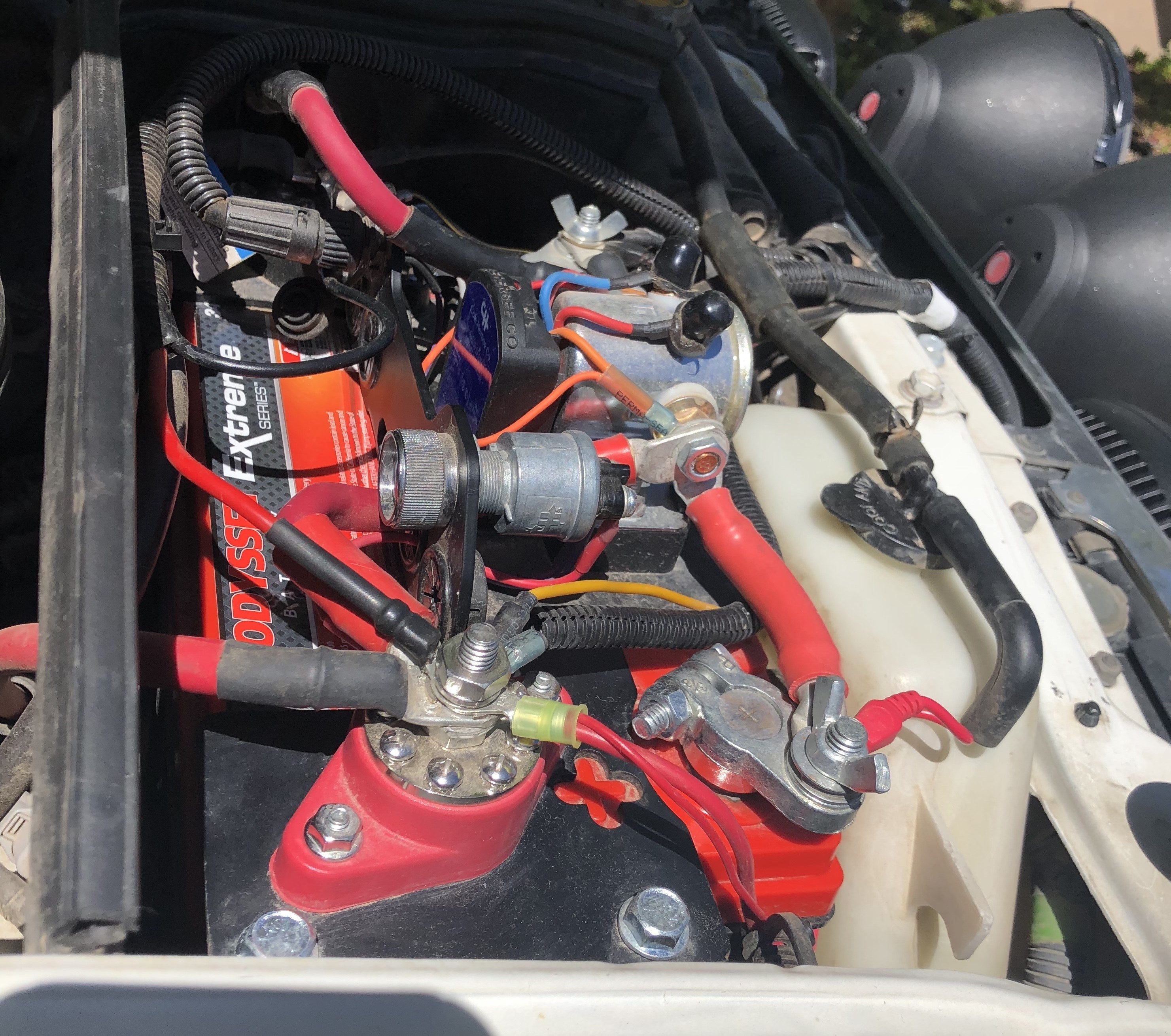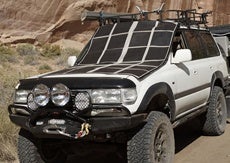My favorite part of the Overland Expo vendor show is cruising the acres of displays to find new products. In recent years, I’d been searching for a better battery management system. In 2015, I created the simplest of dual battery solutions, wiring in parallel an Odyssey PC1700 and a PC2150. Like many K.I.S.S. designs, it was robust but limited in its versatility. Worst of all, it failed in the area that most users want: individualized battery charging and discharge. Enter Genesis Offroad, whose booth I discovered at Expo West in 2016.
Shane and Amy Smith have the type of story and products that I love to learn about. Their journey of creating high-performance electrical components to serve the Jeep market begun in the depth of the Great Recession captured my interest. But it was the features of the products that led me to ask Shane about testing their Universal Dual Battery system. As co-owner and developer of Genesis Offroad, he introduced me to why their products differ from traditional dual battery management systems.
Based in Mississippi, Genesis offers made-in-the-USA products and pairs them with best-in-class Odyssey batteries. Their space-conscious components help owners fit dual battery systems into tight under-hood spaces, at once condensing and miniaturizing the system. Genesis also offers brackets that unite batteries and management components into a single, eye-catching mount. Their line currently consists of JK, Toyota, universal, and Polaris RZR systems. Powder coated 1/8” steel, laser cut and machine bent, is the foundation of these systems, which are specifically designed to fit the popular PC1500 (Group 34) AGM battery from Odyssey snuggly in their brackets for trucks.
The Universal system, which weighs 13 lbs without batteries, is a work of art. It utilizes Cole Hersee components, including their well-regarded 200A isolator on the model we tested. Severe duty 2g welding wire forms the cables of the system, as well as the custom-cut cables Shane offers for configurations that locate the accessory battery apart from the cranking battery. For our Land Cruiser, we required just such a configuration, including segments of the beefy silicone-sheathed cable.
Ironically, the smallest component in the Genesis Offroad system is also the most interesting and, in some ways, the most potent. The G Screen Monitoring System is their answer to the nagging question of what state one’s batteries are in. The G Screen reveals vital data regarding the electrical components, providing click-screen navigation to see each battery’s voltage, which configuration is in use (batteries connected or disconnected), and controls configuration change. A “Boost” feature allows in cab switching for vehicle ignition in instances where the cranking battery has been depleted, and the secondary battery must be drawn upon.
These features make popping the hood to manually switch heavy isolator switches a thing of the past. The “smart” functions of the G Screen relate to its driver alerts for troubling battery conditions, which visually capture your attention with contrasting color changes of the screen (green = both batteries fully charged; yellow = starting battery below 12.7v; red = 1 battery below 12v). Only 1” tall, wide and deep, the G Screen adds minimally to cab control clutter, and its 10’ cabled allows easy wire routing.
Table of contents
Installing the Genesis
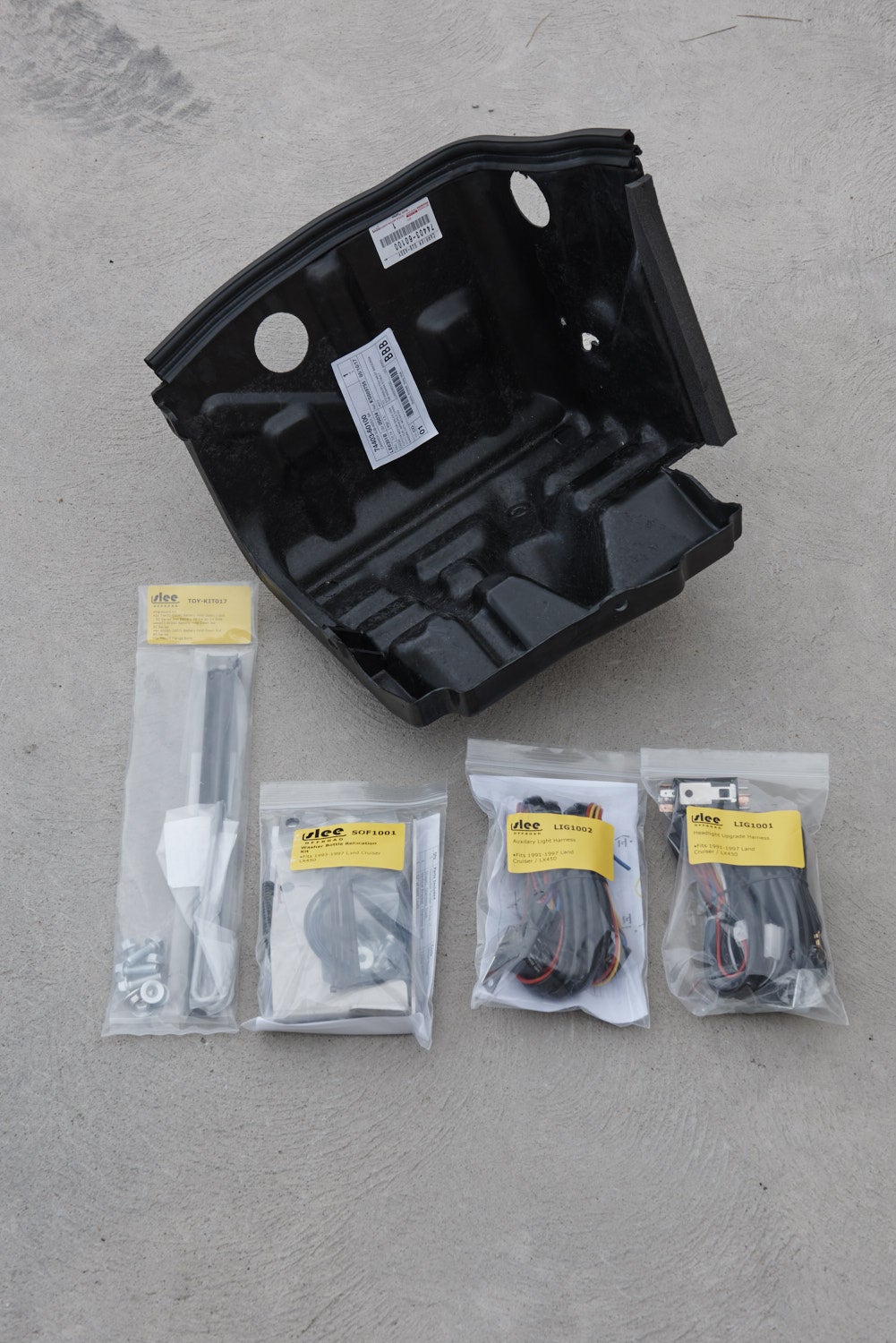
To guide the install, the Genesis Offroad website provides simple, sharp and easy-to-read user diagrams, and Shane’s IT background led him to build in updatable software options (current version is seen as a screen display for reference). While we didn’t have onboard air in the big Toyota, the Genesis system does include a compressed air monitoring option, adding psi readout as a G Screen data point. Adding a compressor later on is made easy by use of a 1/4” NPT port.
Ease of mounting the Genesis system will vary by the vehicle and preferred mounting points. Although Genesis specializes in the wildly popular JK platform (including right-hand drive models), we found the Universal single kit to be the best fit in the Land Cruiser. But doing so would be an exercise in custom fabrication if not for the genius of Colorado’s Slee Offroad. Slee’s 80 Series dual-battery mounting kit provides an all-in-one solution (see section below). While the bottom of the Genesis single kit provides a perfectly flat surface to mount on a support surface, the Slee kit is what creates that surface in the extremely non-flat area behind the passenger’s headlamp. Four bolts will secure the Genesis tray once drilled to match the Slee battery mount. The Slee mount, in turn, aligns with threaded factory mounting points, using provided bolts, and avoiding any need for drilling.
The resulting fit is tight and very solid, requiring only minor trimming to fit the fiber-reinforced nylon mount snugly against the radiator. Although the Slee mount provides the necessary tie-downs for securing a battery, the Genesis universal mount integrates a rigid top plate to press down perfectly on the Odyssey. The fit is so secure the plate includes laser cut-outs in the powder-coated metal for the large, raised + / – symbols atop the PC1500.
For added flexibility, the Genesis system offers expandability for accessory attachments via matching power and ground bus bars (1 heavy duty center stud, surrounded by 7 accessory studs). Optional Quick Connect cables from Genesis mean power port options to service the front and/or rear of a vehicle, as well as cables to connect to the rear of an off-road trailer are easily added. Accessory options for the cables include Quick Connect jumper cables. They can also be used to tie solar panels to the system for charging.
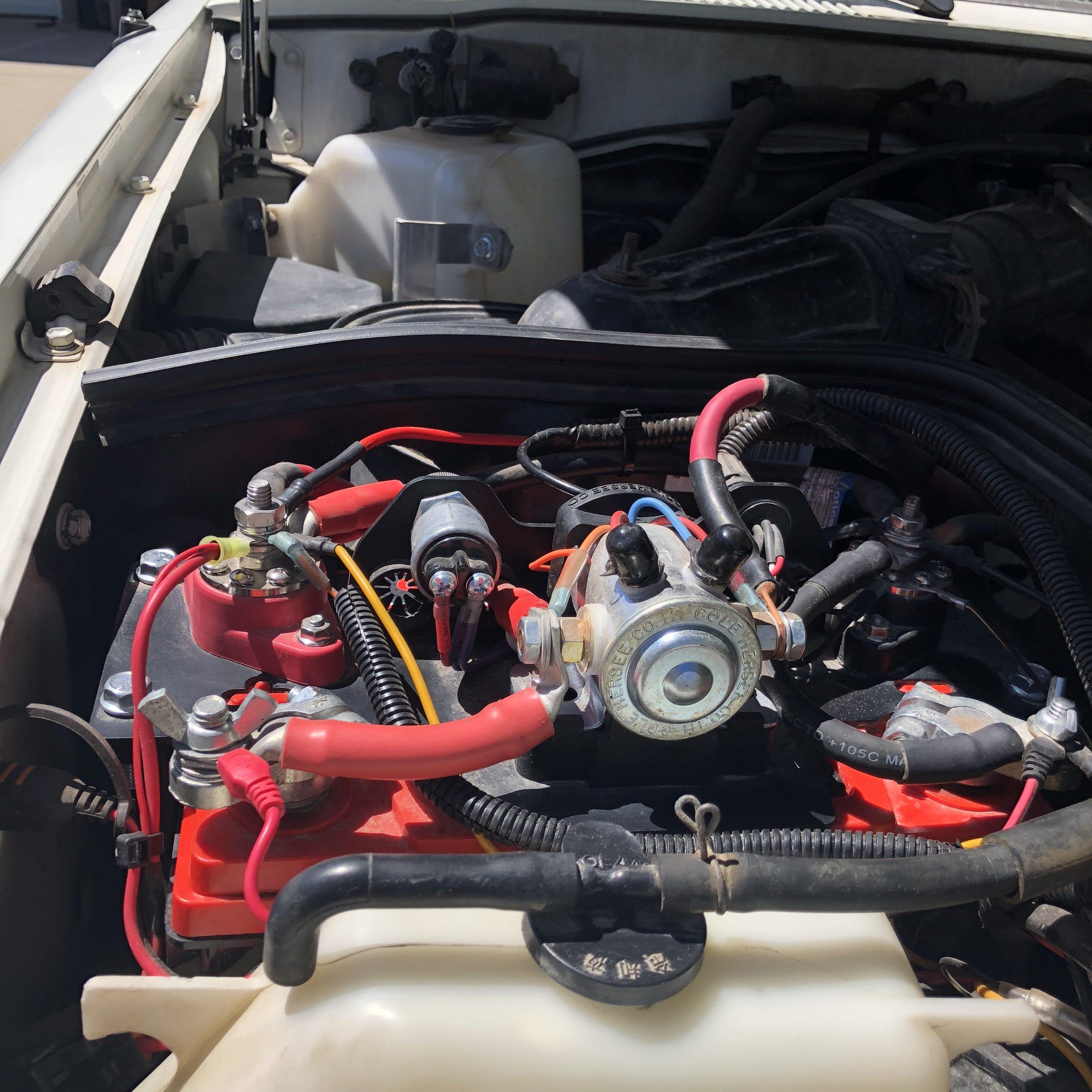
The customization that Genesis Offroad makes available means you can configure the system you need, as well as upgrading it over time. Given the quality of the components in these systems, any dual battery setup worth considering will be an investment in your safety. And I do mean investment. While none of the systems on the market come cheap, competing systems are seldom as easily configured or expanded as what Genesis offers. By adding a host of buyer-driven choices, such as adding batteries and wiring options, Shane has made it super simple to upgrade over time.
All told, the complete Genesis system install, including component relocation and the Slee solutions, can be done in a Saturday. Though not overly technical, thanks especially to the quality instructions Shane provides, there are enough distinct steps involved in making room for the second battery, as well as the wiring, that you don’t want to be in a rush on this install.
Living With the Genesis
A smart system should be designed to think for you, while also offering you information when desired…or when you need to be woken up to issues. I’ll be candid and say I really don’t want to be responsible for remembering to protect my second battery. I expect a battery management system to take care of that, and if a system relies upon me to take a step then its designer has a different idea about what “smart” means.
That was why the Genesis Offroad system stood out to me when Shane began explaining it at Overland West. The integrated processor automatically steps in to isolate your batteries so that, despite any occasional forgetfulness, only one is drained below starting capacity. This means the draw from your fridge isn’t going to leave you unable to start. It also means that if your starting battery is drawn down then the system will also isolate the auxiliary battery, enabling it to still serve as your starting backup.
If you manage to drain the starting battery, the Genesis offers its unique Boost option. Simply press and hold the G Screen to initiate Boost mode, which interconnects both batteries, effectively “jumping” the vehicle from its secondary capacity. Compared to popping the hood of two vehicles and attaching cables, this ingenious system takes mere seconds.
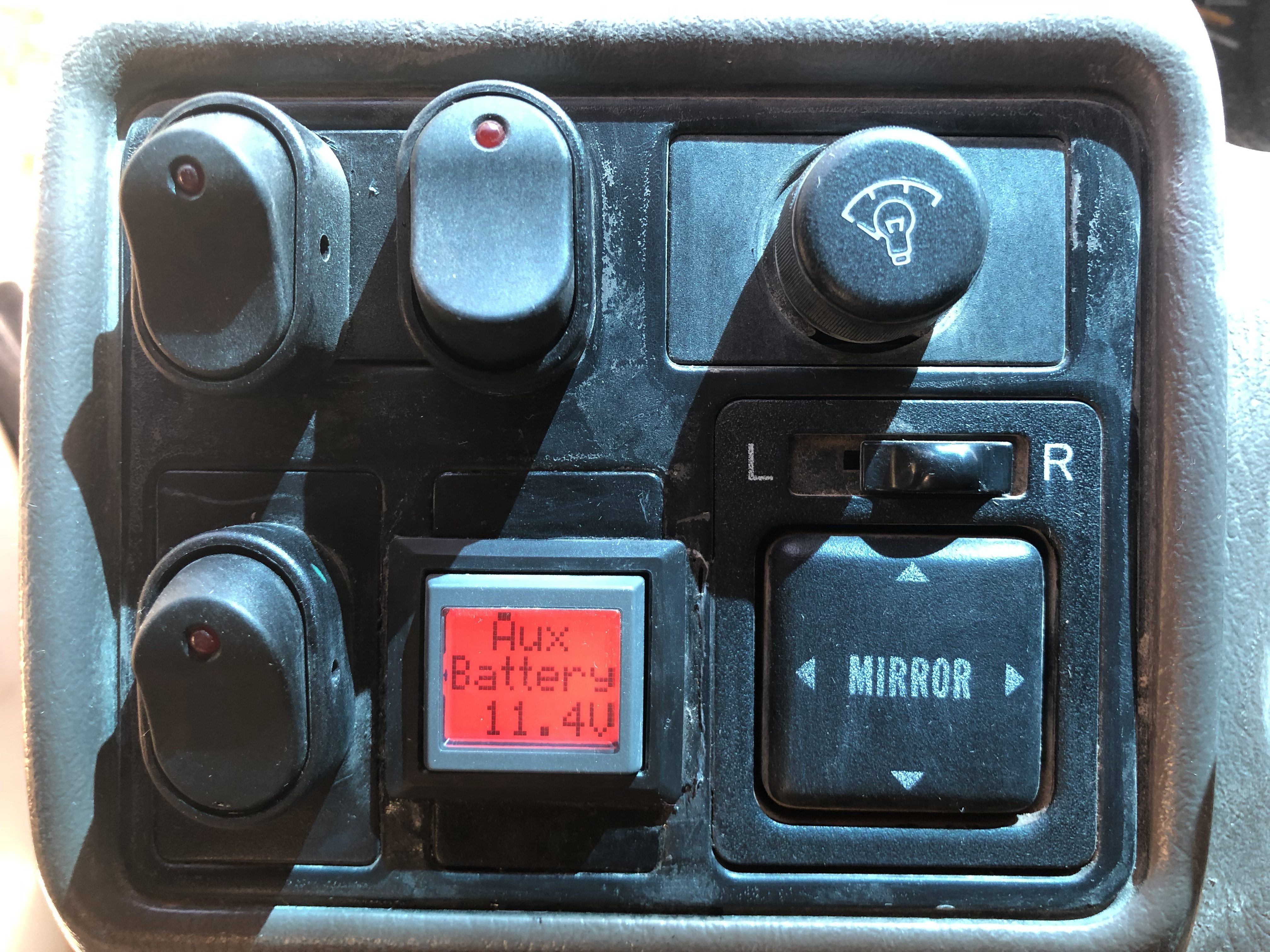
Having jumped plenty of vehicles, I was especially anxious to test the Boost mode. Ironically, the deep capacity of the beefy Odyssey batteries, coupled with the low draw of today’s LED lights, meant it took longer than expected to adequately deplete the primary PC1700. When I did draw it down (initially on purpose, but later from negligence!), the Genesis system’s solution was only a firm button push away. To engage the auxiliary battery’s boosting capacity the G Screen is depressed for 3 seconds, overriding battery isolation that occurs following the low voltage state. This override mode reconnects the batteries for 1 minute. This allows you to then start your truck, but also automatically disconnects to allow isolation for charging and auxiliary battery protection.
Once charging begins after your motor is started, the system’s intelligence again kicks in, but this time in how it prioritizes the alternator’s electricity. Following a Boost jump start, the first minute of alternator charging is split between both batteries. Thereafter it is again solely directed to the starting battery. The Genesis flows 100% of the available electricity to the starting battery until it reaches 13.2v, at which point it then begins recharging the second battery as needed until it attains the same level.
Genesis offers both a standard (85A) and heavy-duty (200A) isolator option. While the prior is fine for stock vehicles, most off-roaders will want the capacity of the upgraded version, which we opted for, as it offers the capacity needed for higher output alternators and numerous demanding accessories. The kit is matched with more of the same 2ga wires, each masterfully finished with soldered, crimped and heat shrink-wrapped connections. According to your vehicle’s needs, the connection wires between the batteries are ordered to custom length, with Shane available to provide needed input.
Given the high demand and ongoing electrical draws in today’s 4x4s, the peace of mind offered by the Genesis Offroad system has created a safety net, as well as a means to assess battery state during and following everyday offroad activities. In particular, massive electrical draw from our Toyota’s big Warn Zeon Platinum 12,000lb winch, and long-term powering of one of SnoMaster’s largest fridge/freezers, are two of the functions we have come to rely upon. They, along with the several pairs of Lightforce lamps we run, mean an overdraw—whether from a malfunctioning alternator, or an excessive demand—is a risk that must be planned for.
Slee Solutions for Land Cruisers
To accommodate an under hood dual battery set up, many rigs will require some shuffling of at least minor components or wiring. Land Cruisers are no different, and Slee Offroad of Golden, Colo., provides the key solutions through both individual items and kits for the 80, 100 and 200 Series, as well as other major Toyota 4x4s. To mount the Genesis system we reached out to Christo Slee, the company’s founder and owner, whose roots are in South Africa and Toyotas. He quickly outlined what we’d need, which consisted of their Washer Bottle Relocation Kit and Second Battery Tray.
Slee provides clear step-by-step instructions for moving the washer bottle aft towards the firewall. The stainless steel brackets situate the bottle neatly next to the air cleaner housing and the cruise control module. As an average to slow shade tree mechanic, the process took me less than two hours, even with the minor wire splicing that’s involved. It’s a slick solution to adding space for the second battery. My only recommendation is that the washer bottle mount would have less flex/vibration if a single metal brace were added, forming the rigidity of triangulation, between the bottle and the two provided braces.
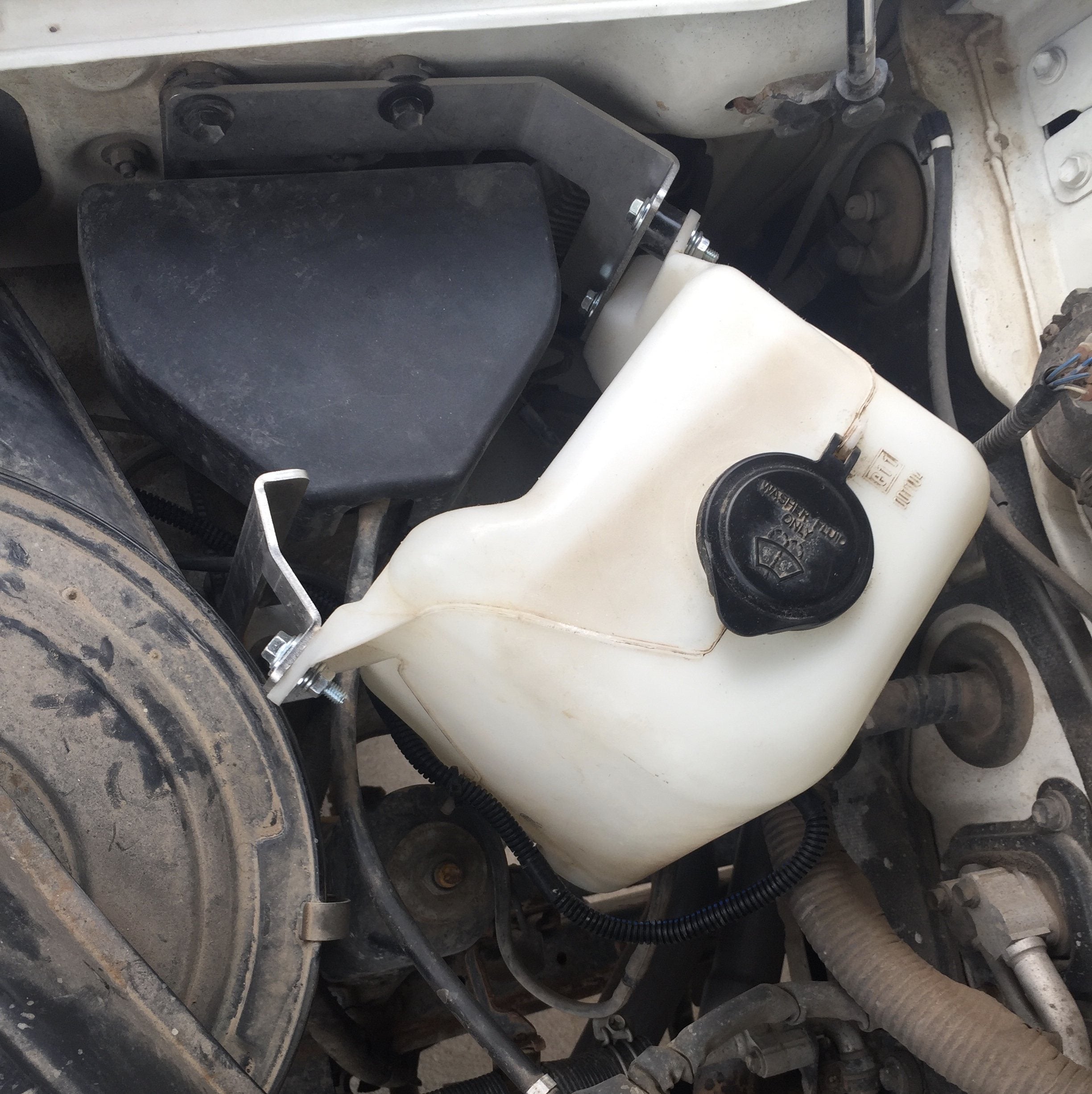
Installation of the Slee Second Battery Tray takes a bit longer, as it involves a bit of trial and error, including minor trimming of the tray’s hard nylon material to fit the fan shroud. A Dremel or jigsaw makes short work of this step. The Genesis tray rests on the mount from Slee with only a single raised nub needing trimmed. Four 1/4” bolts were used to secure the two (high-performance install), following alignment and match drilling of a quartet of holes thru both the 1/8” thick steel tray and the nylon mount. To provide a flush surface for the PC1500’s bottom, a spacer plate was created, lifting the Odyssey just off of the four bolt heads.
One other upgrade makes sense to do when you’re in the midst of these installations. Christo suggested that we also address the Achilles heel of 80 Series lighting: its main headlight harness. This electrical need is well known among Cruiser aficionados, and Slee offers two plug-n-play replacement harnesses to resolve it. The first replaces the main lighting harness, while the second can be added to the latter replacement harness to support auxiliary lights, at once integrating them into the factory light controls.
If you’ve not already added these harnesses, doing so while in the midst of adding a dual battery setup is the right time to tackle the upgrade. With the changes to the engine bay that you’ll be in the midst of, it’ll never be simpler to tap into the headlights. Installation of the main harness took less than two hours, and was rewarded with light output gains that to the driver’s eye appear 20-30% better than OEM. Is the light output sufficient to justify the upgrade? I wondered as much until the first time, shortly after install, when I was driving and found myself reaching to switch off my high beams as a car approached. You guessed it. The improvement in lumen output had convinced my eyes that the little blue dash light must be on. Yet I was still in low beam mode. That about sums up the change, especially when coupled with superior 9011/9012 replacement bulbs, which are readily modified to fit.
Do you need a dual battery system?
Thoughtfully expanding your vehicle’s electrical system is one part adding accessories (loads) and one part compensating for those increased system demands. Aside from increasing alternator output, the most important step towards a capable electrical system is pairing the electrical capacity provided by a second battery (often a deep cycle) with a corresponding battery management system. Above all such systems are designed to allow a secure source of electricity for immediate and future needs. By-and-large that means engine ignition, and, secondarily, powering accessories.
While a weakened battery in town is merely an inconvenience, in the boonies it could mean being stranded (or at least eating some crow). Battery isolation allows you to keep one unit in reserve for starting, while the other serves stationary needs (i.e., accessories), such as running a fridge, or, when combined with the starting battery, to offer a greater supply of electricity for extreme demands such as winching.
If isolating a set of batteries doesn’t sound that complicated, you are right. That is, if you are willing to manually divorce the batteries’ electrical circuits via a heavy-duty switch. And if you are willing to have their charging not intelligently controlled. Unfortunately, simple and cheap(er) products are full of compromises when it comes to dual battery systems. In this case, you definitely get what you pay for.
Maintaining Odyssey Batteries: CTEK Chargers
Charging your vehicle’s battery will eventually put you in the market for a charger, as an alternator alone can’t always suffice in assuring a full charge. From motorcycles to tractors and daily drivers, it seems I am frequently charging one battery or another. When cheap batteries were all we used, a simple Schumacher charger sufficed. But 15 years ago, when we began installing high quality, long-life Odyssey AGM’s, I also stepped up to one of Odyssey’s very own matched chargers. Designed with charging algorithms to correspond with the needs of their unique dense plate battery design, the chargers will also work with traditional flooded acid batteries as well as orbital designs.
We used that Odyssey charger as our go-to solution for years, and appreciated its configuration with three sets of charging cables, thus enabling it to charge/maintain multiple batteries at once, including testing modes. Unfortunately, it was also physically a brute. Weighing 10 lbs and always a handful to manage with its tangle of cables, I privately longed for a more compact charger, one smaller than a briefcase. So it was a pleasant surprise when we again worked with Odyssey to set up the Genesis dual system, and their representative asked if we knew about CTEK. If you are like me, the answer was “negative…who’s that?”

CTEK was established to be a premiere solution to the health and function of automotive batteries and emerged from European battery innovations dating to the early 1980s. Today the Swedish company creates compact, high tech charging/monitoring devices. To replace the cumbersome Odyssey charger, we worked with CTEK to try the MXS 5.0 charger. Dimensionally not dissimilar to a couple of large bars of soap, the most advanced of the company’s chargers arrived in summer 2017, and was immediately put into service on nearly a dozen different vehicles and batteries, ranging from a Kubota to a Yamaha Rhino to various automotive applications including cars and trucks.
If you are in need of a quality charger, consider the decisions by Jay Leno and Porsche, the latter having been the first of many performance car manufacturers to adopt CTEK as their OEM charger. Why CTEK? Advanced electrical systems (and discerning consumers) demand a correspondingly capable charging system. Unlike many daily drivers, a McLaren or Ferrari may be parked for weeks or months between drives. A “trickle charger,” though delivering low voltage, is continuous and ‘dumb’ in the sense of not knowing when to quit. Such traditional chargers don’t listen to feedback from your battery. They just keep on doing their thing. Think of it like a kitchen stove that although set on Low, just keeps heating a pot. The stove doesn’t know when to switch to simmer or simply shut off.
In contrast, CTEK’s smart chargers are built around processors that continuously analyze battery condition, including temperature and sulfation, and couple those capabilities with programming that prioritized battery health, both in maintenance and restoration. It does so through an 8-step process, which I have found will usually complete in an overnight session.
CTEK has a range of products to match various battery needs, along with dizzying array of well thought out connection strategies for simplifying how their chargers interface with your vehicle and battery. We have been utilizing one of those, the Smart Sense, which is connected to your battery’s terminals and provides continuous status information (voltage and temp). Your smartphone receives the Bluetooth signal, providing in cab monitoring for one or more vehicles’ Smart Sense units, via the free Battery Sense app. Offering peace of mind and simplicity, the system provides added details, including history, to augment the touch-of-a-button readout on the Genesis G-screen.
For added convenience, CTEK offers quick attachment cables. The most basic versions allow simple plug-in, O-ring sealed connections to begin charging. This Comfort Connect system is permanently installed to a battery via its posts. Attached to the Odyssey PC1500 via the Genesis terminals, the Comfort Connect eliminates the need for alligator clips on the Land Cruiser, though the MXS 5.0 includes them.
We also tested the more advanced version, the Comfort Indicator Panel. Featuring a trio of charge status lights, the Panel is intended to give instant visual feedback when you want to know battery condition. Our Kubota, which has no voltmeter and a buried battery, was a perfect application for the Comfort Indicator. With its integrated plug-in port, the Panel now gives ready access to attach the charger, as well as signaling via the colored blinking indicator light if any maintenance is needed. More recently, CTEK launched its new CT5 charger, which provides users an accurate estimate of the remaining charging time.
Our Final Verdict
Genesis continues to expand its line of kits, developing dual battery systems for popular makes and models. Most recently, Shane launched a system specifically for the 2016+ Tacoma. Similarly, new software launches mean the Genesis G Screen continues to be updated.
While Genesis Offroad isn’t the biggest outfit in the growing dual battery market, it may offer the most user-friendly and feature-packed dual battery systems. The products are quality through and through, offer drivers dash-mounted monitoring, and help take the guesswork out of maintaining electrical capacities. After waiting over a decade to add a full-function dual battery setup, the simplicity, customer support and performance of the Genesis system has finally provided our Land Cruiser the type of 21st-century functionality we had hoped for.
About the Gear Doctor: Sean Michael has been designing, abusing and testing outdoor gear since the 1980’s. He began reviewing for Off-road.com in 2000, and today lives in the Northern Wasatch Mountains, where he is Director of the Outdoor Product Design & Development program at Utah State University. Follow his trips and gear at thegeardoctor on Instagram.
We are committed to finding, researching, and recommending the best products. We earn commissions from purchases you make using the retail links in our product reviews. Learn more about how this works.
